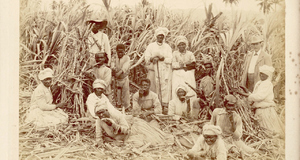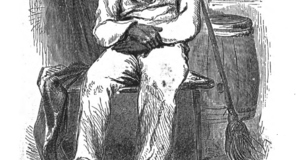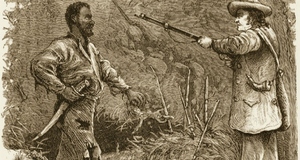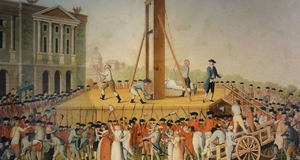Slavery to Self-Liberation: The Haitian Revolution in Marxist Theory
By
2019, Vol. 11 No. 02 | pg. 1/1
KEYWORDS:
The Haitian Revolution of 1791 – 1804 was a successful slave rebellion in the French colony of Saint-Domingue that began in the wake of the French Revolution and went on to influence subsequent liberation movements for decades to come. The Saint-Domingue revolutionaries have been described as having "invented decolonisation" (Nesbitt, 2008: 9), thus making the newly independent Haiti "the first postcolonial state" (ibid.: 56) in 1804, an extraordinary achievement considering that only a few years before, Saint-Domingue had been the world’s most valuable colony. This essay examines the organisation, leadership and participation in the slave uprising in Saint-Domingue. In particular, it will analyse to what extent the example of Toussaint L’Ouverture’s leadership and the success of the slave revolution can support a theoretical framework informed by Rosa Luxemburg’s insistence that revolutionary movements must be a dialectical and historical process, with leadership constantly working for and learning from the masses. Luxemburg’s revolutionary theory is particularly useful when employed alongside The Black Jacobins, C.L.R. James’ remarkable account of the Haitian Revolution, first published in 1938 and later extensively revised, which examines Toussaint and the Saint-Domingue slaves through a Marxist lens influenced by James’ own interest in contemporary liberation struggles and movements for African independence (Fick, 2017: 65). James’ professed from the mid-1950s onwards that, were he to rewrite The Black Jacobins, he would focus more on “the revolutionary and creative power of untaught slaves” (ibid.: 64), and an analysis of the revolution using Luxemburg’s approach to the masses can help to illuminate this aspect. The essay begins by outlining Luxemburg’s revolutionary theory and James’ The Black Jacobins, and explains how Luxemburg’s idea of revolution as a historical and organic process can compliment and expand James’ thesis of plantation slavery as “a quintessentially modern institution of capitalist exploitation” (Buck-Morss, 2014: 57-8). It then moves to analyse the question of why the Haitian Revolution was the only successful slave rebellion in history and how Luxemburg’s theory of the mass strike as a historical moment can be used to explain this success, focusing on the class structure in Saint-Domingue leading up to the insurrection of 1791, the influence of the French Revolution and Enlightenment values, as well as the human agency of the slaves and their leaders.The key to Rosa Luxemburg’s revolutionary thinking is her insistence that revolutions are dialectical, historical processes and at the same time contingent on human agency and the relationship between the masses and their leaders. Like Lenin she argued for the importance of a vanguard party, which would have a necessary wider perspective than localised factions, but she differed in the extent to which this logic was pursued (Scott, 1998: 169). In contrast to Lenin’s ultra-centralism, “[f]or Luxemburg, the party might well be more farsighted than the workers, but it would nevertheless be constantly surprised and taught new lessons by those it presumed to lead” (ibid.). Luxemburg believed this ultra-centralism denigrated the masses, as their “essential virtue becomes ‘discipline’, that is, passive obedience to duty” (Howard, 1971: 264) and prevents them from having a say in the revolutionary process begun in their name. James shared this perspective, espousing that “the people always know during a revolution” (1989: 75-6) and describing as mistakes any time Toussaint failed to listen to and communicate with his mass of supporters (this will be discussed more below). Luxemburg coupled this emphasis on the importance of the masses with a strong understanding of the Marxist dialectic, which provides the teleology of a necessary final goal for a proletarian movement (Howard, 1971: 12). In this point of view, “the present, the ‘facts’, are transitory, and can only be understood in terms of what they were and what they are becoming within the social totality” (ibid.). For Luxemburg and fellow Marxists, the final goal is, of course, socialism. James’ unique adaptation of Marxist thought facilitates a reading of the Haitian Revolution that presents a similar process of becoming, with a final goal of liberation from slavery and self-determination. James describes how, due to their huge numbers and mass working conditions, the slaves of Saint-Domingue “were closer to a modern proletariat than any group of workers in existence at the time, and the rising was, therefore, a thoroughly prepared and organised mass movement” (1989: 86). Whilst James focuses more on the leadership of Toussaint L’Ouverture than on the participation of the slave masses, it is, according to Carolyn Fick, the slaves who “provide the initiative and impetus” in The Black Jacobins and “for the first time, the revolutionary potential of the masses is treated as an integral part of the revolutionary process” (1990: 4). By applying the Marxist dialectic to slavery, the slaves themselves are understood to be in a teleological process towards freedom and thus not defined by slavery. The advantage of adding Luxemburg’s particular understanding of the Marxist dialectic to James’ narrative is that the agency of the masses of slaves is brought into sharper focus within this process. It is, then, an insistence on the adaptability of traditionally rigid Marxist theory that allows Luxemburg to incorporate the agency of the masses into her theory and allows James to apply Marxist ideas to a revolution that occurred half a century before The Communist Manifesto and had as its goal the liberal notions of freedom and independence rather than socialism. Indeed, Susan Buck-Morss describes how
James’ approach in particular represents a significant departure from this orthodox Marxism, which saw liberation for workers contingent on the rise and subsequent downfall of industrial, advanced capitalism. James in The Black Jacobins broke with such conceptions of history “in favour of an approach that recognized the simultaneous coexistence of a plurality of historical times” (Schwarz, 2017: 102). A similar point can be made for Luxemburg, whose “practical, tactical measures […] were always situation specific” (Howard, 1971: 9). Luxemburg’s revolutionary theory is also useful for explaining why the Haitian Revolution was uniquely successful. To understand this success in terms of Luxemburg’s revolutionary dialectic we must situate the insurrection in a historical moment and then examine how the revolutionary slaves reacted to their particular conditions. Prior to the initial slave rebellion of 1791, a complex and factional class structure in Saint-Domingue led to rising tensions within the colony. Despite a universally enforced maxim that “a white is never in the wrong vis-a-vis a black” (Fick, 1990: 18), the whites did not constitute a solid class bloc, but were instead divided into grands blancs - the wealthy plantation owners - and petits blancs, who consisted of lower- and middle-class whites, including plantation managers and clerks, as well as vagabonds and petty-criminals who came to Saint-Domingue specifically because their race would automatically grant them a degree of social respectability (ibid.: 17). As the sugar trade rapidly expanded in the 18th century, tensions increased as the petits blancs witnessed their own prospects of matching the economic fortunes of the grands blancs diminish (ibid.: 18). They also encountered competition from a growing class of Mulattoes and free blacks. The Mulatto class had emerged and expanded rapidly due to growing concubinage of black female slaves by their white masters, and subsequent offers of freedom to their offspring. By 1789, these Mulattoes were near-equal in number to the white population and, despite the perennial inferiority of their social position in relation to any of the whites, had become a considerable economic competitor, due to their freedom to trade coupled with a characteristically thrifty and sober lifestyle in comparison to the whites (ibid.: 19). The greatest factional dispute, however, was between the grands blancs in Saint Domingue and the French bourgeoisie, who had developed a mercantile system called the Exclusive which forced the colonists into exporting their produce to France only. The colonists resented this as they had founded the colony themselves and wished to prosper fully by opening up trade (James, 1989: 46-7). By 1789 “the colony had never been in such a state of social and administrative chaos” (Fick, 1990: 87). It is within this discordant class structure that the slaves began their rebellion. For Luxemburg, the mass strike (for which, for our purposes, we can substitute revolutionary action in general) “is not artificially ‘made’ but is a historical phenomenon resulting from social conditions with historical inevitability” (1925: 10). An effective revolution cannot be willed into existence by a vanguard party but must align with complex historical and social conditions. In light of this we can see the class divisions in 18th century Saint-Domingue as contributing to these necessary conditions, allowing slave resistance to surreptitiously spread and organise as the ruling classes fixated on each other. Fick describes how the
Indeed, slave resistance was not a new phenomenon in Saint-Domingue in 1791 and was by no means unique to that colony. Over the centuries, resistance had taken the form of “partial revolts, conspiracies, plots to kill the master, suicide, infanticide, voodoo, poisonings, marronage” and these “all bore witness to the slaves’ human spirit and capacity to assert an independent will” (ibid.: 75). Whilst Luxemburg would dismiss these resistance tactics as anarchist due to their lack of organisation, and thus inevitably ineffective (1925: 8), they highlight a human consistency of will to resistance that was likely necessary for the later revolutionary success. Fick’s account suggests that the slaves’ spirit for resistance had to be constantly repressed and from this we can hypothesise that, as the ruling factions of Saint-Domingue became increasingly preoccupied with their internal disputes, this spirit for resistance became organised into a revolutionary movement – a Luxemburgian example of mass agency aligning with historical conditions conducive to revolution. The Haitian Revolution is inextricably tied up with the history of the French Revolution and the spread of Enlightenment values of liberty and equality, and this provides another example of Luxemburg’s historical inevitability of social conditions leading to revolution. Buck-Morss describes how a political metaphor of slavery connoting the evil of all power relations began to take hold in European thought just as the slave trade had expanded to form the basis of the entire Western economy, “paradoxically facilitating the global spread of the very Enlightenment ideals that were in such fundamental contradiction to it” (2014: 21). Unsurprisingly, the colonists fighting for their economic freedom from the French bourgeoisie overlooked this paradox (Fick, 1990: 77), but it did not escape the Saint-Domingue slaves, who heard of the events of the revolution in France and inevitably construed them in their own image:
These Enlightenment values were also linked with slavery by abolitionists amongst the French revolutionaries, who managed to successfully disperse the sentiment among the Paris workers who went from “indifference in 1789 […] to detest no section of the aristocracy so much as those whom they called ‘the aristocrats of the skin’” (ibid.: 120). Indeed, Buck-Morss describes how “[t]he Haitian Revolution was the crucible, the trial by fire for the ideals of the French Enlightenment. And every European who was part of the bourgeois reading public knew it” due to the writings and pamphlets of French abolitionists such as the Amis des Noirs, as well as an influential series on the Saint-Domingue events in the popular Minerva magazine (2014: 42). The slaveholding class, then, had reached a historical moment in which the economic structure that had served them so well was no longer compatible with the emerging value system. However, although the French Revolution had sparked the ideal of universal freedom, of which the abolition of slavery was the only possible logical outcome, abolition “did not come about through the revolutionary ideas or even the revolutionary actions of the French; it came about through the actions of the slaves themselves” (ibid.: 36). Indeed, it was not until 1794, three years after the start of the revolution in Saint-Domingue, that France officially abolished slavery, and then only, according to James, to give the demonstrably proficient slave army a concrete interest to fight for France against the British and Spanish who wished to claim the colony (1989: 140). This highlights the significance of Luxemburg’s focus on the importance of the autonomous creativity of the masses to a revolutionary movement (Scott, 1998: 168). Whilst the Marxist dialectic recognises social progression driven by inherent contradictions in the method of material production, Luxemburg’s agency-focused theory shows us specifically how real people drive these progressions from below and can enable us to theorise the ways in which the leaders of the Saint-Domingue slaves were able to use developing historical conditions to their advantage. This brings us to the leaders of the revolution themselves. A major purpose of The Black Jacobins is to present Toussaint L’Ouverture’s character and leadership as exceptional, the key driver of the slaves’ revolution, at least until the latter stages when the struggle moved towards a fight for independence. James establishes this exceptionalism by highlighting how Toussaint’s background differed from the average Saint-Domingue slave, as he had received an elemental education in his younger days and had been free for a number of years by the start of the insurrection (James, 1989: 20). James seems to both attribute Toussaint’s exceptionalism to his particular conditions and to attribute his conditions to his exceptional character, highlighting how his education as well as “unusual intelligence” caused him to be singled out, given privileges and, eventually, granted freedom by his master (ibid.). This relatively advantaged position then facilitated his leadership role, as James states
However, it was not until the revolution was well underway that Toussaint would emerge as its supreme leader (ibid.: 90). The initial insurrectionary movement in northern Saint-Domingue in 1791 was initiated by the slaves Boukman Dutty, Jeannot Bullet, Jean-Francois and Georges Biassou, as well as other representatives from individual northern plantations (Fick, 1990: 92). These early leaders’ actions were remarkably close to those of a Marxist vanguard party, considering they lacked any semblance of revolutionary training. They would organise weekly clandestine meetings in the forest, consisting of two delegates from every northern plantation with numbers approaching two hundred in total. Here they painstakingly planned the general insurrection, which was to take place on August 22nd and would entail setting each plantation alight on a given signal, driving out the plantation managers, and holding on to the territory (ibid.: 91). At this point, Toussaint used his position of relative freedom to serve as a link between the leaders and to disseminate information and instructions (ibid.: 92). These tactics closely resemble Luxemburg’s prescriptions for the mass strike and for revolutionary action in general. Like Lenin, Luxemburg argued for the importance of a vanguard party who could more easily see the totality of a situation than localised workers (Scott, 1998: 169), but she criticised those members of the vanguard who attempted to artificially force a mass strike when conditions were not conducive to it, warning against seeing the mass strike as “a technical means of struggle which can be ‘decided’ or ‘forbidden’ at pleasure” (Luxemburg, 1999). It can be argued, then, that with their carefully planned insurrection, representatives from different plantations, and effective central planning, the Saint-Domingue slaves constituted a successful vanguard in the Luxemburgian vein, especially considering its opportune timing in relation to the rising tensions among the ruling classes as discussed earlier. This leads to two related questions: how did the untrained slaves develop such effective revolutionary tactics, and, once the revolution was underway, why were their fledgling armies so formidable? Whilst James attributes a lot of this success to the exceptional characters of Toussaint and the other slave leaders (1989, 94: 116), John Thornton (1993) presents a fascinating alternative theory that many of the Saint-Domingue slaves were both militarised and politicised in the extensive civil wars of the Kongo kingdom in Central West Africa, as upwards of sixty percent of the slaves in the Northern Province of Saint-Domingue appear to have hailed from this region. As well as military experience, Thornton suggests that, for Saint-Domingue, “Kongo might be seen as a fount of revolutionary ideas as much as France was” (ibid.: 186), as these ideas were disseminated and passed down to the children of the slaves originally brought to Saint-Domingue from Kongo. This reinforces the idea of the slave leaders as a vanguard party as well as allowing us to see the Haitian Revolution as a reminder that all peoples have histories, and the histories of Kongo, in addition to the more widely known revolutionary history of Europe, shaped the history of Haiti and the idea of slave rebellion. Toussaint eventually emerged as a supremely skilled military and political leader, assuming control of Saint-Domingue after the revolution’s initial insurrectionary phase and, through a combination of tactical nous and delicate diplomacy, brought the island to a position to push towards independence (James, 1989: 185). However, James argues that in the latter stages of the revolution, Toussaint made a number of mistakes that eventually caused his downfall. After the abolition of slavery, Toussaint believed that the salvation of Saint-Domingue lay in the restoration of agriculture (ibid.: 155). To this end, he allowed the white former slave-owners to retain control of their plantations and forced the ex-slaves to continue their previous work, but now for a wage (ibid.: 156). James suggests that the masses of Saint-Domingue may have been receptive to this policy had Toussaint communicated his intentions effectively: “[h]is error was his neglect of his own people. They did not understand what he was doing or where he was going. He took no trouble to explain” (ibid.: 240). This is contrasted with the commander Dessalines, who boldly declares his intention to lead the island to independence and tells the masses of the coming war against France (ibid.). For James, Dessalines’ communication with the masses is the reason he, and not Toussaint, eventually led the island to independence, as Toussaint had become “shut up within himself, immersed in diplomacy […], overconfident that he had only to speak and the masses would follow” (ibid.). Fick echoes this sentiment, suggesting that the ex-slaves’ African heritage, memories of the middle passage, and acquired military skill had imbued them with a particular desire to determine their own futures.
These mistakes can be seen as an example of the opposite of Luxemburg’s prescriptions for effective revolutionary leadership. As discussed above, Luxemburg viewed Leninist ultra-centralism as stifling and dangerous to a revolutionary movement. Jacqueline Rose describes how Luxemburg insists that “the unprecedented, unpredictable nature of the revolutionary moment be carried over into the life that follows, the period after revolution has taken place” (2014: 41). Luxemburg would recognise, then, that by attempting to dictate the direction of Saint-Domingue after the revolution with no input from the masses, Toussaint was exerting a dangerous amount of centralised control. Indeed, Luxemburg wrote that the worst evil of slavery was “the exclusion of slaves from mental life” (Luxemburg, 2004: 22). From this perspective, it is no surprise that the ex-slaves of Saint-Domingue lost faith in Toussaint as he tried to dictate the direction of their lives. It is interesting that Toussaint’s centralism caused his own downfall but did not derail Saint-Domingue on its path to independence, suggesting that the former slaves’ military prowess and will to create their own future were too strong to be diverted by the mistakes of one man. As Luxemburg once warned Lenin, “[r]evolutions do not allow anyone to play schoolmaster with them” (Luxemburg, 1969: 90). ConclusionWhilst it is illuminating to examine the actions of the revolutionary slaves in Saint-Domingue using Marxist theories, there are of course important differences between 18th century slaves and an industrial era proletariat, the most significant being that the extent of the slaves’ exploitation and the misery of their lives were both exponentially greater than modern workers in the developed world. Interestingly, the extreme exploitation of slavery meant that the tactic of focusing on gradual reform rather than revolution, which provided bitter debate between leftists in the late 19th and early 20th centuries and Marxists such as Luxemburg abhorred (Scott, 1998: 129), was never an option in Saint-Domingue, as the gradual reform of slavery was both politically impossible and economically unfeasible; the only choice was between slavery and revolution. However, the differences between the Saint-Domingue slaves and a modern proletariat do not prevent the Haitian Revolution from being a particularly useful unit of analysis for Marxist revolutionary theory. Indeed, as the Saint-Domingue slaves were so extreme in their oppression and achieved such great revolutionary success against overwhelmingly powerful forces, it can also be valuable to use the Haitian Revolution to critique Marxist prescriptions for revolutionary success. For example, the Haitian Revolution shows that effective leadership, political talent and military nous are essential drivers of history. These factors are fundamentally contingent on individual participants, which would appear to qualify more deterministic Marxist accounts of history but are compatible with Luxemburg’s more agency centered approach. This essay has attempted to show how Luxemburg’s understanding of the revolutionary process can better describe the events of the Haitian Revolution than other, more rigid Marxist theories, and how her formulation of the role of the masses can compliment James’ more leadership focused account. ReferencesBuck-Morss, Susan (2014) Hegel, Haiti, and universal history (Pittsburgh: University of Pittsburgh Press). Fick, Carolyn (1990) The making of Haiti: the Saint Domingue revolution from below (Knoxsville: University of Tennessee Press). Fick, Carolyn (2017) “C.L.R. James, The Black Jacobins, and The Making of Haiti” in Forsdick, Charles and Høgsbjerg, Christian (eds.) The black jacobins reader (Durham: Duke University Press). Howard, Dick (ed.) (1971) Selected political writings of Rosa Luxemburg (New York: Monthly Review Press James, C.L.R. (1989) The black jacobins (New York: Vintage). Luxemburg, Rosa (1925) The mass strike, the political party and the trade unions (Detroit: Marxist Educational Society of Detroit). Luxemburg, Rosa (1969) “The mass strike” in Nettl, Peter (ed.) Rosa Luxemburg (Oxford: Oxford University Press). Luxemburg, Rosa (1999) Organisational questions of the Russian social democracy, accessed at https://www.marxists.org/archive/luxemburg/1904/questions-rsd/ 10 December 2017. Luxemburg, Rosa (2004) “Slavery,” in Hurdis, Peter and Anderson, Kevin (eds.) The Rosa Luxemburg Reader (New York: Monthly Review Press). Nesbitt, Nick (2008) Universal emancipation: the Haitian revolution and the radical Enlightenment (Charlottesville: University of Virginia Press). Rose, Jacqueline (2014) Women in dark times (London: Bloomesbury). Schwarz, Bill (2017) “Haiti and historical time” in Forsdick, Charles and Høgsbjerg, Christian (eds.) The black jacobins reader (Durham: Duke University Press). Scott, James (1998) Seeing like a state: how certain schemes to improve the human condition have failed (New Haven: Yale University Press). Thornton, James (1993) ““I am the subject of the King of Congo”: African political ideology and the Haitian Revolution,” Journal of World History 4(2): 181-214. Suggested Reading from Inquiries Journal
Inquiries Journal provides undergraduate and graduate students around the world a platform for the wide dissemination of academic work over a range of core disciplines. Representing the work of students from hundreds of institutions around the globe, Inquiries Journal's large database of academic articles is completely free. Learn more | Blog | Submit Latest in Political Science |


















